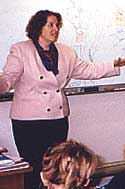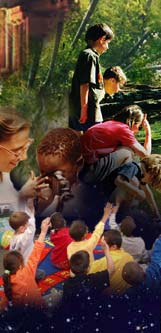 |
 |
PROFESSIONAL
DEVELOPMENT

Vision
and the Scientific Habit of Mind:
Interdisciplinary Curriculum Design
DESCRIPTION. The purpose of this 30-hour course
(5 days, 6 hours per day) is the creation of several interdisciplinary
curricula. You will learn to do this by:
* bringing the world of museums into the everyday classroom environment
through actual visits or by taking "virtual field trips," and by
sharing these experiences with other teachers and students,
* learning new ways of encouraging the development of "a scientific
habit of mind" in all our students, while opening new doors to cooperative
educational ventures in the arts and sciences,
* creating an interdisciplinary learning environment which resembles
life, with the intention of teaching problem-solving strategies,
and
* fostering an appreciation for the interconnectedness of our lives
on this planet.
The course will follow the interdisciplinary theme, "Vision and
the Scientific Habit of Mind," which we designed, based on a Smithsonian
exhibit on "Science in American Life" at the National Museum of
American History. In the first part of this exhibit, we enter the
laboratory of chemists Ira Remsen and Constantin Fahlberg at Johns
Hopkins University as they argue the issue of which one actually
discovered saccharin. At one point, Remsen discounts the importance
of who actually should benefit from the discovery, and reflects
upon the ultimate aim of teaching:
"To develop a scientific habit of mind in our students,
and to train them to become investigators."
Through the "Science in American Life" exhibit
(or comparable one), teachers will construct together a "thematic
unit" addressing subjects that have traditionally only been taught
in isolation: e.g. science, music, mathematics, reading and writing,
art, history, health, physical education. Materials and activities
will be provided. The teachers will have some classroom work, considerable
field work (in museums and at school), and a visit to an educational
toy store to identify toys, games, and software which will fit appropriately
with the curricula they create for their specific classrooms. Questions
intended to facilitate transfer of the teachers' new understandings
to their own classrooms will be considered and shared.
Course Outline
SESSION 1
Introduction: A Teacher's Metacognitive View or "Thinking About
What We're Thinking" Reviewing and understanding your own educational
philosophy
Questions to consider: How to build consensus on a schools' or a
group's educational philosophy.
Review: What is a "curriculum?" What is an "interdisciplinary curriculum?
Discussion of the content, foundation, method, philosophy, the stated
and implied goals, overt agendas, covert agendas, and hidden agendas.
Discussion of Theme Validity 1) Validity Within the Disciplines;
3)Validity Beyond the Disciplines; 2) Validity For the Disciplines;
4) Contribution to Broader Outcomes.
SESSION 2
Site Visit: "Science in American Life," Hands-On Science Room, or
related museum exhibit.
Take content and procedural notes, photographs, videos, make audio
recordings, gather documentation, participate in hands-on activities,
speak with scientists and docents. The purpose of the museum trip
is to expose teachers to the ways in which historic figures ---
visionaries --- developed a scientific habit of mind through their
own discoveries, and how their works have now become inextricably
linked, for better or for worse, to all aspects of our lives.
Debriefing
Creating an Interdisciplinary Theme
Curriculum guidelines, sample frameworks, examples of interdisciplinary
units provided and discussed. Development of themes
SESSION 3
Trip to Educational Toy Store
Discuss materials needed to implement the curriculum, and the value
of certain toys to facilitate learning and to evaluate student understanding.
Practical issues: use of hands-on books, toys, games, models, CD-ROMS,
software to access Internet resources; museum photos, slides, exhibits;
school & local library resources & personnel, local businesses.
SESSION 4
Work on Thematic Interdisciplinary Units.
Incorporate materials acquired from toy store, ideas from classroom
experience, and group brainstorming; follow general criteria and
guidelines.
Consult library and/or Internet resources.
SESSION 5
Presentations
Teachers present their Interdisciplinary Curricula to each other
and discuss practical issues of implementation, directions for future
projects, and assessment criteria.

CyberEthics Project
|
 |

